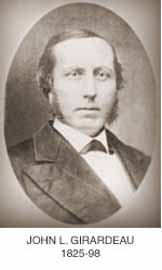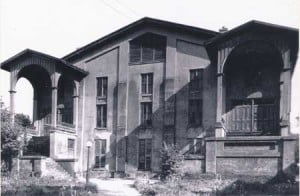John Lafayette Girardeau (14 November 1825 – 23 June 1898)
by Dr. C. N. Willborn, formerly associate professor of Church History and Biblical Theology at the Greenville Presbyterian Theological Seminary and currently pastor of the Oak Ridge Presbyterian Church, Oakridge, TN.
©PCA Historical Center, 12330 Conway Road, St. Louis, MO, 2004. All Rights Reserved.
 John Lafayette Girardeau was born as Lafayette Freer Girardeau on November 14, 1825 to John Bohun Girardeau and Claudia Herne Freer Girardeau. The parents of young Girardeau were of French Huguenot descent and, by the time of their eldest son’s birth on James Island (across the Ashley River from Charleston), possessors of a rich colonial ancestry, which included at least one Revolutionary War hero. John Bohun (a planter) and Claudia Freer were also solid Presbyterians of the Scottish type. The Holy Scriptures and Westminster Standards were the standard fare for the Girardeau children with both father and mother active in their religious upbringing.
John Lafayette Girardeau was born as Lafayette Freer Girardeau on November 14, 1825 to John Bohun Girardeau and Claudia Herne Freer Girardeau. The parents of young Girardeau were of French Huguenot descent and, by the time of their eldest son’s birth on James Island (across the Ashley River from Charleston), possessors of a rich colonial ancestry, which included at least one Revolutionary War hero. John Bohun (a planter) and Claudia Freer were also solid Presbyterians of the Scottish type. The Holy Scriptures and Westminster Standards were the standard fare for the Girardeau children with both father and mother active in their religious upbringing.
Also important in Girardeau’s formative years were two notable pastors, Aaron W. Leland and Thomas Smyth. Leland was the wee lad’s pastor on James Island and Smyth nurtured him during his early adolescent years in Charleston. Although Leland was of English ancestry, he was of the Scottish persuasion when it came to his theology and ecclesiology. Smyth was of Scotch-Irish background and pastor of the Second Presbyterian Church in Charleston. The lowcountry Presbyterians had from the first identified with Scotland rather than the Mid-Atlantic Presbyterians. This was no doubt true because of Archibald Stobo, the pioneering Scot who founded the earliest distinctly Presbyterian churches in the South.
Girardeau was educated on James Island and in Charleston, completing Charleston College (now College of Charleston) in 1844 at the age of seventeen. He graduated with first honors (valedictorian) as a Greek and Latin scholar. Upon his graduation, Professor William Hawksworth exclaimed to those around him, “There goes a fine Greek scholar to make a poor Presbyterian preacher.”
![Girardeau, John Lafayette [14/11/1825-23/06/1898]](https://thisday.pcahistory.org/wp-content/uploads/2013/06/girardeau-167x300.jpg) After a year of tutoring and teaching on James Island and Mt. Pleasant (to raise money), he matriculated at the Theological Seminary of the Synod of South Carolina and Georgia (later Columbia Theological Seminary). As a ministerial student at Columbia he studied under his childhood pastor, Aaron W. Leland, and the venerable George Howe. Girardeau supplemented his seminary education by regularly attending the pulpit ministrations of Benjamin Morgan Palmer at the Presbyterian Church (now First Presbyterian), a short walk from both the seminary and South Carolina College. The seminarian also placed himself under the tutelage of James Henley Thornwell at the College (now University of South Carolina). Thornwell was at the time Professor of Moral Philosophy and preached or lectured regularly in the college chapel (Rutledge Chapel). Girardeau and other seminary students attended Dr. Thornwell’s addresses assiduously. Indeed, Girardeau attributed Dr. Thornwell’s chapel addresses with giving “shape and form” to his theology, which was already stoutly Westminsterian.
After a year of tutoring and teaching on James Island and Mt. Pleasant (to raise money), he matriculated at the Theological Seminary of the Synod of South Carolina and Georgia (later Columbia Theological Seminary). As a ministerial student at Columbia he studied under his childhood pastor, Aaron W. Leland, and the venerable George Howe. Girardeau supplemented his seminary education by regularly attending the pulpit ministrations of Benjamin Morgan Palmer at the Presbyterian Church (now First Presbyterian), a short walk from both the seminary and South Carolina College. The seminarian also placed himself under the tutelage of James Henley Thornwell at the College (now University of South Carolina). Thornwell was at the time Professor of Moral Philosophy and preached or lectured regularly in the college chapel (Rutledge Chapel). Girardeau and other seminary students attended Dr. Thornwell’s addresses assiduously. Indeed, Girardeau attributed Dr. Thornwell’s chapel addresses with giving “shape and form” to his theology, which was already stoutly Westminsterian.
As a child of Claudia Herne Girardeau, the scion of South Carolina had learned to respect the poor and needy of society. During the latter years of college he had held regular meetings for the slaves on his father’s plantation, exhorting them to believe the gospel and rest upon Christ for their deliverance from sin. In seminary he held evangelistic meetings in a warehouse where the poor, enslaved, derelict, and disreputable attended. Shortly after graduation from seminary in 1848 he was ordained to the ministry of word and sacrament and embarked upon a brief series of pastorates-Wappetaw Church and Wilton Presbyterian Church-that would culminate in Charleston as a famous pastor to slaves.
In January 1854, he and his wife Penelope Sarah (“Sal”) moved from St. John Parish and Wilton Presbyterian Church (January 1849-December 53) to Charleston to assume the work begun by John B. Adger and the session of Second Presbyterian Church. The work was designed to establish a church for and of the slaves. In 1850, citizens of Charleston built a meeting house on Anson Street for the exclusive use of the slaves. After Adger’s health failed, Girardeau was handpicked by Adger and Smyth to lead the work forward. The work expanded from thirty-six black members when Girardeau arrived to over 600 at the time of the American Armageddon. He preached to over 1,500 weekly from 1859 through 1861.
 In 1858/59 the Anson Street Mission experienced a marvelous revival and in April 1859 they moved into a new building at the prestigious and prime intersection of Meeting and Calhoun Streets. The black membership was given the privilege of naming their church (which was particularized in 1858) and they chose “Zion.” Zion Presbyterian Church became famous for Girardeau’s preaching—he was called “the Spurgeon of America”—but it was also noteworthy for its diaconal ministry in the community, catechetical training of hundreds in the city, sewing clubs for the women, and missionary activity. The outreach and influence of Zion was of such public notoriety that Girardeau and the session were often criticized and sometimes physically threatened. For example, the catechetical training and teaching of hymns and psalms was so effective that some Charlestonians believed Girardeau was teaching the slaves to read for themselves (which was contrary to state law).
In 1858/59 the Anson Street Mission experienced a marvelous revival and in April 1859 they moved into a new building at the prestigious and prime intersection of Meeting and Calhoun Streets. The black membership was given the privilege of naming their church (which was particularized in 1858) and they chose “Zion.” Zion Presbyterian Church became famous for Girardeau’s preaching—he was called “the Spurgeon of America”—but it was also noteworthy for its diaconal ministry in the community, catechetical training of hundreds in the city, sewing clubs for the women, and missionary activity. The outreach and influence of Zion was of such public notoriety that Girardeau and the session were often criticized and sometimes physically threatened. For example, the catechetical training and teaching of hymns and psalms was so effective that some Charlestonians believed Girardeau was teaching the slaves to read for themselves (which was contrary to state law).
Pictured above right, Zion Presbyterian Church, Charleston, South Carolina.
After the War and before Girardeau could return to Charleston, a number of freedmen of Zion Presbyterian Church beckoned Girardeau to return to “the Holy City” and resume his work with them. They desired to have their white pastor whom they knew, loved, and respected, rather than a black missionary from the North. Throughout the post-War and Reconstruction years, he arduously worked amongst both black and white in Charleston. He mightily labored within the Southern Presbyterian Church to see that the freedmen were included in the church and in 1869 he nominated seven freedmen for the office of ruling elder in Zion Presbyterian Church, preached the ordination service, and with the white members of his session laid hands on his black brothers.
Unfortunately, the pressures of Reconstruction and the Freedmen’s Bureau, and the hardened positions of notables like B. M. Palmer and R. L. Dabney brought the church to a pivotal moment. The weight of political and social issues eventuated in “organic separation” of white membership and black membership and the formation of churches along the color line. Girardeau alone dissented against the resolution at the 1874 General Assembly in Columbus, Mississippi, for which he served as Moderator.
In 1875, B. M. Palmer nominated Girardeau for Professor of Didactic and Polemic Theology at Columbia Seminary, a position W. S. Plumer had held since 1866. In January 1876 he began his seminary labors which lasted until June 1895. During his academic career he continued as a popular preacher in the Southern Church, defended biblical orthodoxy against the inroads of modernism in the Woodrow Controversy at Columbia Seminary, labored actively against union with the Northern Presbyterian Church, served the courts of the church tirelessly, contributed many theological, ecclesiological, and philosophical articles to academic journals, and wrote several important monographs on theology, worship, and philosophy. He made significant contributions to the doctrine of adoption and the diaconate.
 Girardeau and his beloved wife “Sal” had ten children who crowned their forty-nine years of marriage. Seven Girardeau children lived to adulthood while three died in infancy. Three Girardeau daughters married Presbyterian ministers, including the notable theologian and churchman Robert Alexander Webb. This pastor to slaves and theologian of the Southern Church died quietly at his home in Columbia on June 23, 1898, just a few months after his friend R. L. Dabney had passed away. B. M. Palmer wrote of Girardeau that “It will be long before another generation can produce his equal; and those, who have known him from the first to last, feel that we lay him to rest among the immortals of the past.” His body rests just a few short steps from his mentor and friend James Henley Thornwell in Columbia’s Elmwood Cemetery.
Girardeau and his beloved wife “Sal” had ten children who crowned their forty-nine years of marriage. Seven Girardeau children lived to adulthood while three died in infancy. Three Girardeau daughters married Presbyterian ministers, including the notable theologian and churchman Robert Alexander Webb. This pastor to slaves and theologian of the Southern Church died quietly at his home in Columbia on June 23, 1898, just a few months after his friend R. L. Dabney had passed away. B. M. Palmer wrote of Girardeau that “It will be long before another generation can produce his equal; and those, who have known him from the first to last, feel that we lay him to rest among the immortals of the past.” His body rests just a few short steps from his mentor and friend James Henley Thornwell in Columbia’s Elmwood Cemetery.
Pictured above right: The stone marking the grave of John L. Girardeau.
Tags: Anson Street Mission, James Island, South Carolina College, Zion Presbyterian Church

No comments
Comments feed for this article